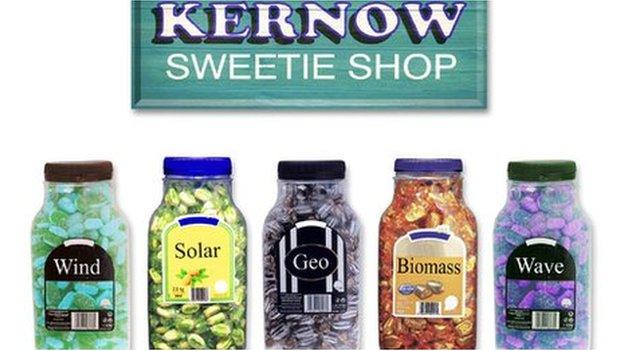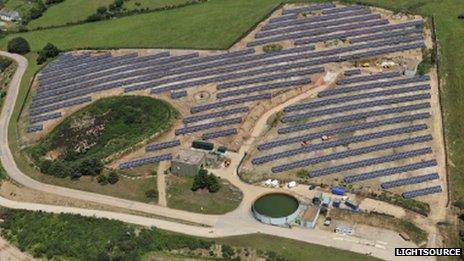Fears over Cornwall solar farm 'gold rush'
- Published

Cornwall has been portrayed as a "sweetie shop" of renewables
In 2009 Cornwall Council portrayed the county as a "sweetie shop" for renewable energy.
The authority said it was "preparing for a solar power gold rush" and forecast that developments in this technology could lead to up to £1bn of investment.
The council has now approved nearly 50 solar farms covering more than 1,600 acres.
But concerns have been raised that the "gold rush" is trampling local communities.
Cornwall's first commercial solar farm was built at a disused tin mine at Wheal Jane near Truro.
It was switched on in 2011 and its 5,680 solar panels produce enough electricity to power about 430 homes.
But it is dwarfed by some of the more recently built solar farms and those in the pipeline.
Planning permission has just been given for Cornwall's largest solar farm so far, covering more than 130 acres at Maxworthy near Launceston.
And Lizzie Webster and her family fear their isolated home at Maxworthy could be surrounded.
Another solar farm is being considered next to their property by Good Energy.
She said: "I can just see our lives disappearing, that's the reality of renewable energy.
"Effectively they will totally close us in. I grew up in Cornwall and I would not want to see the destruction of this county.
"It's time Cornwall woke up to what is happening to it."

Wheal Jane was the first commercial solar farm approved in Cornwall
Two other schemes, including one for a solar farm at Sweetshouse near Bodmin were refused because of the impact on the areas.
They were the first refusals of solar farms by the Conservative-Independent led unitary authority.
'Generous incentives'
Cornwall Council did not have any figures for the amount of investment in solar farms so far.
But according to the Renewable Energy Association, there are nearly 450 renewable energy companies in the region, turning over "close to £1bn".
Regen SW, an independent sustainable energy centre, estimates in its 2012 report that the electricity production capacity of solar farms in the region is now at least 75 megawatts - enough to power about 15,750 South West homes.
Regen said more than 2,000 people were employed in the solar energy businesses in the region out of a total of nearly 10,000 in renewable electricity.
The total number of solar projects in the South West, including small-scale domestic, increased from 7,500 in 2010/2011 to almost 55,000 in 2011/2012.
Overall, renewable energy now contributed about 5.5% of electricity demand in the South West, lower than than the national figure of 11%.
It expects the growth in solar to continue as costs continue to fall.
Chief executive Merlin Hyman said using renewable energy was "common sense" in the face of rising costs, volatility in supplies and falling reserves of fossil fuels.
"In the West Country, we have some of the best resources of renewable energy in the UK," he said.
"Once built, on the whole they are free and non-polluting.
"They are also more likely to create jobs and keep income in the local economy.
"Solar has a role to play, but it is important the developments go in the right places and do not conflict with agricultural use and go through proper scrutiny."
He added: "We shall start to see more turned down because the obvious spaces are starting to be used up.
"The technology might develop too so we could see more being incorporated into buildings such as at the top of car parks."
Good Energy said its plans were at a "scoping" stage, to assess the Maxworthy site's technical suitability.
It said that it was an "ethical company" and felt "very passionate" about local people's views,
The firm said it wanted to create more "positivity" about renewable energy and had offered people living near its Delabole wind farm in Cornwall a 20% discount if they switched electricity suppliers to Good Energy.
Kronos declined to comment after the planning decision.
Cornwall Council said: "The 'sweet shop' presentation highlights the opportunities for Cornwall to take forward the green agenda - not a promotion of Cornwall to developers.
"Individual planning applications are carefully assessed to ensure that their impact on residential amenity, landscape/visual, amenity of visitors and other factors is acceptable.
"Should issues arise from construction or operational noise, this would be dealt with."
Howard Roberts, chairman of Lanlivery Parish Council, which objected to the Sweetshouse scheme, said: "We can't have these giant industrialisations of the fields.
"Let's hope the council will start refusing more of these because we can't go on and on."
- Published23 November 2012
- Published23 November 2012
- Published19 November 2012
- Published8 November 2012
- Published14 June 2012
- Published7 July 2011
- Published24 January 2011